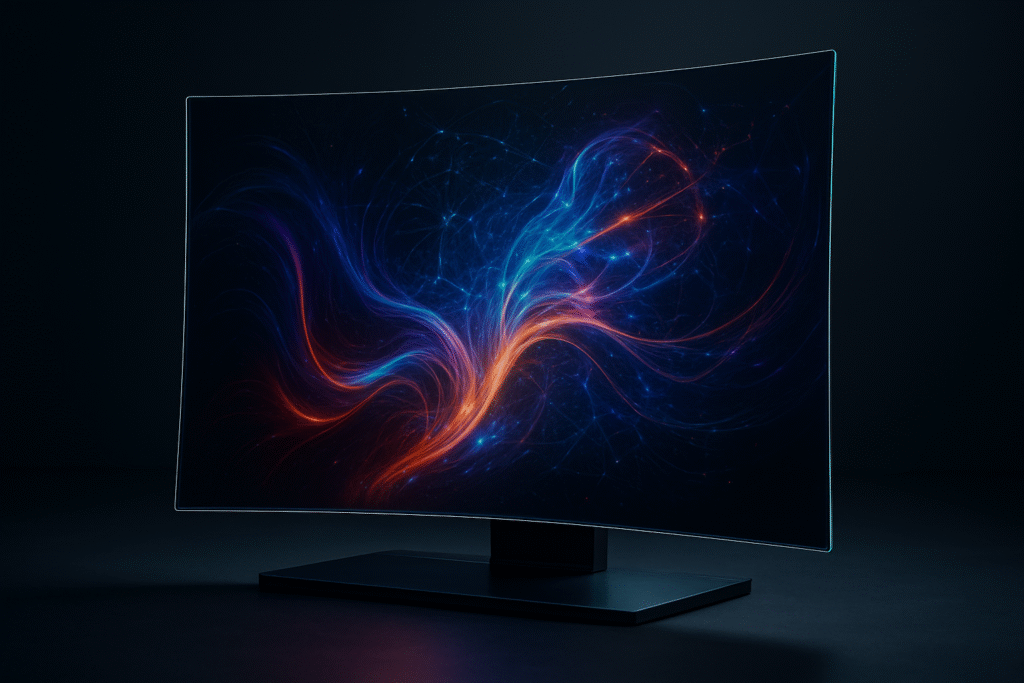
In an era where technology increasingly intertwines with every facet of human creativity, LG Electronics (KRX: 066570) stands at the forefront, transforming how we perceive and interact with art. Through its groundbreaking OLED display technology, LG is not merely providing screens but crafting a new digital canvas that empowers artists and delivers unparalleled immersive experiences to audiences worldwide. This innovative approach is redefining the boundaries of artistic expression, bridging the gap between traditional art forms and cutting-edge display capabilities.
The strategic integration of LG OLED into the global art scene, exemplified by high-profile partnerships with institutions like the Guggenheim Museum, the National Gallery in London, and major art fairs like Frieze, underscores a profound shift. These collaborations highlight a future where art is no longer confined to static mediums but can be dynamically presented, reinterpreted, and experienced with breathtaking clarity and depth, thanks to the unique attributes of OLED.
Unpacking the Technical Brilliance Behind Artistic Immersion
At the heart of LG's artistic revolution lies its self-emissive OLED technology, a significant departure from traditional backlit displays. Unlike LCDs, each pixel in an OLED panel generates its own light and can be individually turned on or off. This fundamental difference enables perfect black levels and infinite contrast, rendering artworks with an astonishing degree of depth and subtlety. The absence of backlighting means there's no "halo" effect around objects against dark backgrounds, ensuring that an artist's vision, particularly in nuanced shadow details, is presented with absolute fidelity.
Furthermore, LG OLED displays boast accurate and lifelike color reproduction, ensuring that the artist's palette is conveyed precisely as intended. This fidelity is crucial for preserving the emotional impact and intricate details of digital and digitized artworks. Beyond conventional flat panels, LG's innovation extends to remarkable design flexibility. The LG SIGNATURE OLED T, a transparent OLED television, offers up to 40% transparency, allowing content to seamlessly blend with its surroundings. This groundbreaking feature creates multi-dimensional artistic encounters, where viewers can perceive art in relation to its physical environment, or even interact with it from behind. Artists like Do Ho Suh have lauded transparent OLED for transforming two-dimensional pictures into three-dimensional spaces, revealing previously invisible layers. Similarly, the LG SIGNATURE OLED R, a rollable display, offers unprecedented integration into diverse environments, disappearing when not in use and redefining how art can inhabit a space. These thin, light, and energy-efficient panels, coupled with advanced processing to minimize noise and improve low luminance performance, represent a technical leap that empowers artists with unprecedented creative freedom.
Initial reactions from the art community and industry experts have been overwhelmingly positive. Artists like Steven Harrington have praised the technology for expanding their artistic possibilities, while curators and institutions recognize its potential to engage audiences in entirely new ways. The ability to present intricate film installations, digital paintings, and even reinterpreted historical works with such precision and immersive quality marks a significant evolution in art presentation.
Reshaping the Landscape for AI and Tech Innovators
The profound integration of LG OLED technology into the art world carries significant implications for AI companies, tech giants, and startups alike. LG Electronics itself stands to benefit immensely, solidifying its position not just as a consumer electronics leader but as a pivotal enabler of cultural and artistic innovation. This strategy diversifies its market appeal, moving beyond traditional hardware sales to influencing high-value cultural sectors. The partnerships with prestigious art institutions and fairs enhance LG's brand perception, associating it with sophistication, cutting-edge design, and artistic patronage.
For other tech giants involved in display technology or digital content creation, LG's success in this niche could spur increased investment in similar high-fidelity, flexible display solutions. Companies like Samsung (KRX: 005930), which also produces OLED displays, might intensify their efforts to carve out their own space in the art market, leading to a competitive race for artistic collaborations and technological advancements tailored for cultural applications. This could potentially disrupt the market for traditional projectors and static art displays in galleries and museums, pushing them towards more dynamic and interactive digital solutions.
AI companies and startups specializing in digital art, generative AI, and immersive experiences also stand to gain. The availability of advanced digital canvases like LG OLED empowers these companies to showcase their creations with unprecedented impact. AI-powered art generation, virtual reality art, and interactive installations can achieve their full potential when rendered on displays capable of perfect contrast and color accuracy. This creates a new demand for content optimized for transparent, rollable, and high-fidelity screens, fostering innovation in digital art creation tools and platforms. Furthermore, the "LG Guggenheim Art and Technology Initiative" directly supports artists at the intersection of art and technology, creating an ecosystem where AI-driven art can flourish and gain mainstream recognition.
A Broader Canvas: Significance in the AI and Art Landscape
LG OLED's foray into the art world is more than a product placement; it represents a significant milestone in the broader convergence of technology and culture. It underscores a growing trend where advanced display technologies are recognized not just as tools for consumption, but as integral components of artistic creation and experience. This development fits perfectly within the broader AI landscape, where AI is increasingly being used to generate, curate, and enhance artistic endeavors. The perfect display acts as the final, crucial interface between AI-generated or AI-enhanced art and the human viewer.
The impacts are multi-faceted. On one hand, it democratizes art by making high-quality digital reproductions and original digital art accessible to wider audiences, potentially beyond the confines of physical galleries. On the other, it elevates the status of digital art, giving it a physical presence and gravitas comparable to traditional mediums. Potential concerns, however, include the preservation of digital art in an ever-evolving technological landscape, ensuring authenticity, and addressing the digital divide in access to such advanced experiences. Comparisons to previous AI milestones, such as AI's ability to generate photorealistic images or compose music, highlight this as the next frontier: not just creating, but perfectly presenting and experiencing these new forms of art. The collaboration between LG and institutions like the Guggenheim is a testament to this, establishing frameworks for the research, honor, and promotion of artists working at this intersection.
The Horizon: Future Developments and Artistic Frontiers
Looking ahead, the intersection of LG OLED technology and the art world promises a future brimming with innovative possibilities. Near-term developments will likely see an expansion of partnerships with more artists, galleries, and cultural institutions globally. The continued refinement of transparent and rollable OLED technologies will unlock even more creative applications, allowing for dynamic installations that interact with architecture and space in unprecedented ways. Experts predict a surge in digital-native art forms specifically designed to leverage these unique display characteristics, moving beyond simply displaying existing art to inspiring entirely new genres.
On the horizon, we can anticipate further integration with augmented reality (AR) and virtual reality (VR) experiences, where OLED displays might serve as portals to extended realities, blending physical and digital art seamlessly. The potential for interactive art experiences, where viewers' movements or biometric data influence the displayed artwork, is also immense. Challenges to address include developing standardized formats for digital art preservation, ensuring the longevity of these technologies in artistic contexts, and fostering digital literacy among artists and audiences. As Ayoung Kim prepares to be featured as the third recipient of the LG Guggenheim Award, the art world watches to see how these pioneering artists will continue to push the boundaries of what's possible with advanced display technology.
A New Dawn for Art and Technology
The emergence of LG OLED technology as a premier digital canvas marks a pivotal moment in the history of art and technology. It's a testament to the idea that technological advancement can be a catalyst for profound artistic expression, not merely a tool. The perfect blacks, vibrant colors, and groundbreaking design flexibility of OLED displays are not just technical specifications; they are the brushstrokes of a new era, enabling artists to realize visions previously confined to imagination.
This development signifies more than just a new way to view art; it's about creating entirely new art forms and experiences. The ongoing collaborations with Frieze, the Guggenheim, and individual artists highlight a future where art is dynamic, immersive, and deeply integrated with the technological fabric of our lives. As we move forward, the art world will undoubtedly continue to explore the vast potential of these digital canvases, pushing creative boundaries and inspiring new generations of artists and art lovers. Keep an eye on the "LG OLED Art" platform (lgoledart.com) and major art events in the coming months, as this revolution in art display is just beginning.
This content is intended for informational purposes only and represents analysis of current AI developments.
TokenRing AI delivers enterprise-grade solutions for multi-agent AI workflow orchestration, AI-powered development tools, and seamless remote collaboration platforms.
For more information, visit https://www.tokenring.ai/.







